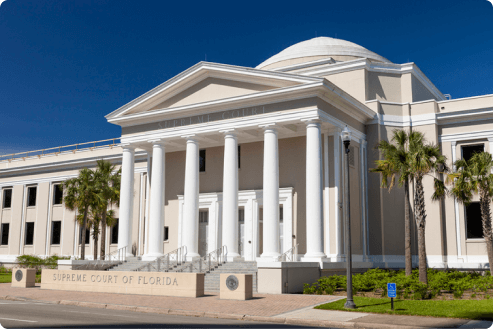
Fort Lauderdale, FL 33394
- $50 Million Recovered
- Serves Clients Nationwide
- Rated in the Top 10 Asbestos and Mesothelioma Trial Lawyers
Qualified mesothelioma lawyers can help patients in Florida file a claim for compensation. Top asbestos law firms have recovered millions on behalf of clients in the state.

Consulting an asbestos attorney about filing a mesothelioma claim in Florida is the first step. It’s important to find a lawyer who has helped families with a mesothelioma diagnosis. They can manage the filing process for you.
Filing allows families to pursue compensation. This can cover expenses such as medical bills and lost wages.
Key Facts About Asbestos Claims in Florida
Florida has deadlines, or statutes of limitations, for filing. These apply to both personal injury and wrongful death claims.
An experienced mesothelioma attorney can assess how these may apply or if there are exceptions in your case.

Get help finding an attorney who knows the process and can get you and your family the compensation you deserve.
Get Help NowIf your exposure was in Florida, it’s important to work with a lawyer experienced in the state. Each state sets its own laws on the litigation process. Florida’s rules on asbestos litigation tend to favor defendants more often than is the case in some other states. A top attorney knows how to navigate complex rules to manage your mesothelioma claim.
For example, Florida allows setoffs when someone files both a lawsuit and asbestos trust fund claims. Florida limits the liability of a company that merges with one that has asbestos liabilities. There’s a cap on any potential liability. It’s based on the value set at the fair market value of the total gross assets of the company holding liability at the time of the merger.
Your lawyer should know the rules for asbestos litigation in Florida. They should also know the asbestos laws in the Florida Administrative Code. Mesothelioma lawyers have helped Floridians get compensation for occupational asbestos exposure and secondary exposure.
Choosing a Florida mesothelioma law firm with a proven track record in is crucial. Experienced firms have secured settlements and verdicts for clients like you.


Top Florida mesothelioma law firms are well-versed in the state’s specific laws and regulations. They can help you explore your legal options. This includes filing claims with asbestos trust funds or filing a lawsuit.
Florida residents may also choose a national mesothelioma law firm. These firms have comprehensive knowledge and resources. They can take on large asbestos manufacturers that acted negligently in exposing you or a loved one to asbestos.





Some national asbestos law firms don’t have physical offices in Florida. However, they have asbestos attorneys licensed in the state. They’ll come to you for interviews and depositions at no cost to you.
Florida juries have awarded multimillion-dollar verdicts to plaintiffs with mesothelioma. While these are examples of jury verdicts, most mesothelioma lawsuits are settled out of court.
National mesothelioma law firms regularly secure mesothelioma settlements worth more than a million dollars. Law firms with experience handling asbestos exposure cases also regularly secure 6-figure payouts from asbestos trust funds.
A mix of federal and state laws govern Florida asbestos claims. Florida’s asbestos legislation is outlined in the Florida Administrative Code. For example, all schools in the state manage asbestos under the guidance of the Asbestos Hazard Emergency Response Act. This is a provision of the federal Toxic Substances Control Act.
Federal laws, such as the Clean Air Act, provide a layer of regulation in addition to the state’s asbestos laws. In 1982, the Florida Department of Environmental Protection started its Asbestos Removal Program. The program aims to protect the public from the asbestos released during renovation and demolition.
An experienced Florida mesothelioma attorney can navigate these rules to secure the highest level of compensation for you. They have the experience and power to stand up to the companies that caused you or your loved one to develop mesothelioma.
Asbestos exposure in Florida doesn’t happen through the environment, but people still get exposed to it on jobsites. Many workers in Florida have breathed in asbestos fibers while on the job. Some retirees moved to Florida after working in other states where they were exposed. They later developed mesothelioma or lung cancer.
Old buildings in Florida may still contain legacy asbestos products such as tiles, cement roofing and other construction materials made with asbestos. Florida has the second-highest number of deaths from mesothelioma and asbestosis in the U.S.
Factories and jobsites across the state used plenty of asbestos. Military bases also exposed service members to asbestos. NASA used asbestos in equipment and building materials, including blocks for soldering and parts of pressurized vessels.
Locations in Florida Linked to Asbestos Exposure
Florida leaders work hard to manage places where asbestos is known to exist. In 1982, the state started a special program to monitor asbestos removal after the EPA gave Florida the power to enforce the rules. The Florida DEP Asbestos Removal Program aims to stop asbestos fibers from getting into the air.
The program requires people to alert the Florida DEP before they remove asbestos. The program covers certain types of buildings, such as schools, businesses, government buildings and factories. It also includes apartment buildings with 4 or more units, ships and active and inactive waste sites.
Many people in Florida were exposed to asbestos while working in construction, mining and power plants. The state had 5 asbestos processing plants that put workers at risk. People who worked in shipyards, chemical plants, metal shops and auto repair faced high exposure, too.
Jobs in schools, electrical work, plumbing and home repair also carried risks. Some workers unknowingly brought asbestos dust home on their clothes, which exposed their family members through secondhand exposure. Others were exposed through talc products like makeup and baby powder, which may contain asbestos.
Florida Occupations With Higher Asbestos Risks
Florida laws help protect people from asbestos exposure by ensuring licensed asbestos removal companies eliminate or contain asbestos safely. The state also has rules that let people hold asbestos companies accountable for the diseases their products caused.
It does not cost anything to hire a mesothelioma attorney in Florida. A mesothelioma attorney represents you on a contingency fee basis (no win, no fee) so that you have no out-of-pocket costs. The mesothelioma attorney only receives a fee if they obtain compensation for you and your heirs.
Answered By: Carl Money, Mesothelioma Attorney, Nemeroff Law Firm
You must find a national firm that specializes in representing mesothelioma cases, and they will determine the best jurisdiction to pursue litigation against the asbestos companies in Florida and to file claims against the asbestos trusts.
Answered By: Carl Money, Mesothelioma Attorney, Nemeroff Law Firm
There is no average payout for mesothelioma victims in Florida or any other state. Any compensation is determined by the evidence obtained against the asbestos companies pursued in litigation and asbestos companies in which claims were filed against the asbestos trusts.
Answered By: Carl Money, Mesothelioma Attorney, Nemeroff Law Firm
Your web browser is no longer supported by Microsoft. Update your browser for more security, speed and compatibility.
If you are looking for mesothelioma support, please contact our Patient Advocates at (855) 404-4592
The Mesothelioma Center at Asbestos.com has provided patients and their loved ones the most updated and reliable information on mesothelioma and asbestos exposure since 2006.
Our team of Patient Advocates includes a medical doctor, a registered nurse, health services administrators, veterans, VA-accredited Claims Agents, an oncology patient navigator and hospice care expert. Their combined expertise means we help any mesothelioma patient or loved one through every step of their cancer journey.
More than 30 contributors, including mesothelioma doctors, survivors, health care professionals and other experts, have peer-reviewed our website and written unique research-driven articles to ensure you get the highest-quality medical and health information.
My family has only the highest compliment for the assistance and support that we received from The Mesothelioma Center. This is a staff of compassionate and knowledgeable individuals who respect what your family is experiencing and who go the extra mile to make an unfortunate diagnosis less stressful. Information and assistance were provided by The Mesothelioma Center at no cost to our family.LashawnMesothelioma patient’s daughter


Lahav, J. (2025, July 1). Florida Mesothelioma Lawyers. Asbestos.com. Retrieved July 15, 2025, from https://www.asbestos.com/mesothelioma-lawyer/florida/
Lahav, Joe. "Florida Mesothelioma Lawyers." Asbestos.com, 1 Jul 2025, https://www.asbestos.com/mesothelioma-lawyer/florida/.
Lahav, Joe. "Florida Mesothelioma Lawyers." Asbestos.com. Last modified July 1, 2025. https://www.asbestos.com/mesothelioma-lawyer/florida/.
Founding Partner at Meirowitz & Wasserberg, LLP
Associate Attorney at Meirowitz & Wasserberg, LLP
A mesothelioma lawyer who specializes in asbestos litigation reviewed the content on this page to ensure it is legally accurate.
Samuel Meirowitz represents plaintiffs across the United States in mesothelioma and asbestos legal cases. He is a partner at the Manhattan-based Meirowitz & Wasserberg law firm.
Our fact-checking process begins with a thorough review of all sources to ensure they are high quality. Then we cross-check the facts with original medical or scientific reports published by those sources, or we validate the facts with reputable news organizations, medical and scientific experts and other health experts. Each page includes all sources for full transparency.
Please read our editorial guidelines to learn more about our content creation and review process.
